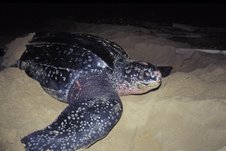 Another highlight of the night was the second largest leatherback to nest this season. “Big Mama,” as some of the crew affectionately named her, was 172 centimeters (Curved Carapace Length). As Scott was examining another leatherback farther down the beach, he found a long-line hook stuck in her right flipper. Using pliers, he successfully pulled the hook out and she crawled back down the beach and slipped into the water.
Another highlight of the night was the second largest leatherback to nest this season. “Big Mama,” as some of the crew affectionately named her, was 172 centimeters (Curved Carapace Length). As Scott was examining another leatherback farther down the beach, he found a long-line hook stuck in her right flipper. Using pliers, he successfully pulled the hook out and she crawled back down the beach and slipped into the water.Then, we broke off into groups of 5-6 students
 per Nature Seeker guide. Each group went to a different zone of the beach to observe and learn tagging techniques from the more experienced guides. We watched for turtles emerging from the surf and also patrolled the upper edge of the beach for leatherbacks that had already chosen a spot to make their nest. Once a turtle reaches an appropriate location she’ll start digging the light-bulb shaped hollow that will hold her eggs. When she’s laid 15-20 eggs we can start tagging or check for tags using our red lights and a scanner for the PIT tags. We wait until this point and use red light so she isn’t startled and discouraged
per Nature Seeker guide. Each group went to a different zone of the beach to observe and learn tagging techniques from the more experienced guides. We watched for turtles emerging from the surf and also patrolled the upper edge of the beach for leatherbacks that had already chosen a spot to make their nest. Once a turtle reaches an appropriate location she’ll start digging the light-bulb shaped hollow that will hold her eggs. When she’s laid 15-20 eggs we can start tagging or check for tags using our red lights and a scanner for the PIT tags. We wait until this point and use red light so she isn’t startled and discouraged  from laying. Turtles are tagged for re-identification using 2 methods: flipper tagging and PIT tagging. Flipper tags are metal clips attached to the turtle’s back flippers using pliers. They are placed to give the turtle room to grow but can often come dislodged as the animal gets larger. PIT tags, however, are microchips permanently imbedded in the muscle of the left front flipper via syringe. These last for the duration of the turtle’s life.
from laying. Turtles are tagged for re-identification using 2 methods: flipper tagging and PIT tagging. Flipper tags are metal clips attached to the turtle’s back flippers using pliers. They are placed to give the turtle room to grow but can often come dislodged as the animal gets larger. PIT tags, however, are microchips permanently imbedded in the muscle of the left front flipper via syringe. These last for the duration of the turtle’s life.After dragging ourselves out of bed Monday morning, the day started with a lecture on the biology of leatherbacks by Scott. He discussed their morphology and how well adapted they are to living in the marine environment. The lecture also included many aspects of leatherback ecology. We broke for lunch and then meet back up for an engaging lecture from Steven Poon from the Trinidad Forestry Division about the government’s contribution to leatherback conservation. He also talked about the challenges of micromanaging local conservation efforts.
This afternoon was another exciting excursion as we all ventured off into the jungles of Trinidad.
 We were promised the reward of a refreshing dip in the Matura River, but little did we know the trek would be so arduous, wrought with giant spiders, a termite’s next, algae covered rocks, and slippery inclines. Overall, the trip was an enjoyable one, though. Parrots could be seen flying overhead, and the bluish-green waters of the Matura River with its waterfalls was well worth the trip. We all relished the chance to swim in the humid weather, and some people jumped of a rock into the deepest part. Our nice guide Francis agreed to pose for an action shot of him slashing undergrowth with his crazy cool machete. He was quite skilled at carving trails for us to follow during our adventure. After the exhausting hike, we enjoyed another hardy dinner and prepared for another night of turtle hunting!
We were promised the reward of a refreshing dip in the Matura River, but little did we know the trek would be so arduous, wrought with giant spiders, a termite’s next, algae covered rocks, and slippery inclines. Overall, the trip was an enjoyable one, though. Parrots could be seen flying overhead, and the bluish-green waters of the Matura River with its waterfalls was well worth the trip. We all relished the chance to swim in the humid weather, and some people jumped of a rock into the deepest part. Our nice guide Francis agreed to pose for an action shot of him slashing undergrowth with his crazy cool machete. He was quite skilled at carving trails for us to follow during our adventure. After the exhausting hike, we enjoyed another hardy dinner and prepared for another night of turtle hunting!~Beth, Michelle, Marcie & Andrew

1 comment:
sounds like the trip's already been a success. did we shed any tears at first sight of the magnificent leatherback, beth?
i can't wait to hear all about it. love you.
Post a Comment